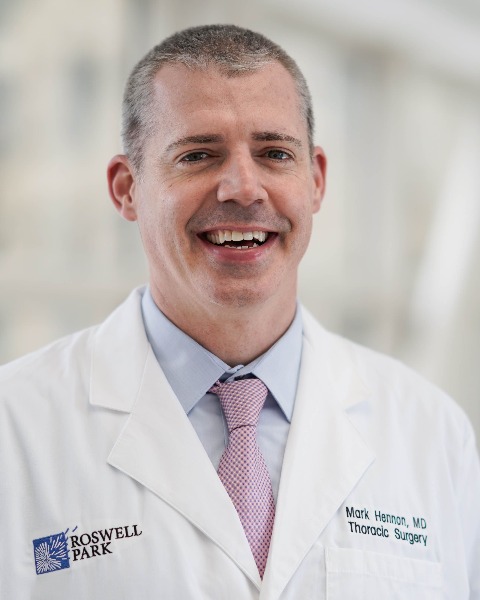Thoracic
P26: Unique recurrence dynamics for nonsmall cell lung cancer tumors < 2cm suggest different optimal surveillance strategies

Mark W. Hennon, MD
Thoracic Surgeon
Roswell Park Comprehensive Cancer Center
Buffalo, New York, United States
Mark W. Hennon, MD
Thoracic Surgeon
Roswell Park Comprehensive Cancer Center
Buffalo, New York, United States
Mark W. Hennon, MD
Thoracic Surgeon
Roswell Park Comprehensive Cancer Center
Buffalo, New York, United States- ED
Elisabeth Dexter, MD
Thoracic Surgeon
Roswell Park Comprehensive Cancer Center, United States - TD
Todd Demmy, MD
Professor
Roswell Park Comprehensive Cancer Center, United States - CN
Chukwumere Nwogu, MD
Professor of Surgery
Roswell Park Comprehensive Cancer Center, United States - KA
Kristopher Attwood, PhD
Biostatistician
Roswell Park Comprehensive Cancer Center, New York, United States - AG
Adrienne Groman, MS
Biostatistician
Roswell Park Comprehensive Cancer Center, United States - SY
Sai Yendamuri, MD, MBA
Professor and Chair of Thoracic Surgery
Roswell Park Comprehensive Cancer Center
Buffalo, New York, United States
Oral Poster Presenter(s)
Submitter(s)
Author(s)
Increasingly, surgeons are operating on smaller NSCLC cancers. Whether these small cancers follow the same time-dependent recurrence patterns as larger tumors. Current guidelines and expert recommendations are based on experience predominantly with larger tumors. We sought to assess these dynamics in a contemporary series to assess appropriateness of current guidelines.
Methods:
This is a retrospective single institution study of 1861 patients who underwent surgical resection of nonsmall cell lung cancer at an NCI designated comprehensive cancer center between January 1, 2010 and December 31, 2020. 526 Stage I and II patients with tumors less than 2 cm were compared to 649 with tumors greater than 2 cm. Epanechnikov kernel-smoothed time-dependent hazard functions for tumors < or ≥ 2 cm were plotted and compared. Based on these findings, different surveillance interval schedules were modeled and analyzed for acceptable rates of disease recurrence at each timeframe.
Results:
A total of 1175 stage I and II patients were included. 76% were stage I, 24% were stage II. 57.5 % (676) were female. Median age was 68 years. Tumor histology was adenocarcinoma in 51.5% (697) of patients, squamous cell carcinoma in 30.9% (363), and other in 9.7% (115). Mean tumor size was 13.6 mm in the < 2 cm group, and 37.4 mm in the ≥ 2 cm group. Mean lymph nodes sampled was 13.3. Figure 1 shows that the hazard function for recurrence is qualitatively different for tumors < 2cm, with no discernible peak. For tumors ≥ 2cm, a clear peak at ~ 18 months with a fall to baseline peak was observed. Risk of recurrence in intervals between surveillance for different schemata demonstrated that yearly surveillance, instead of more intensive surveillance (6 monthly) in the first two years after surgical resection was acceptable.
Conclusions:
NSCLC tumors < 2cm have markedly different recurrence dynamics. This may imply different surveillance schema. If our observation is verified by other investigators, this will likely have a great impact on surveillance costs. This impact will likely increase over time, given the increasing proportion of smaller tumors that surgeons resect in the United States.
Learning Objectives:
- understand current recommendations for postsurgical surveillance after resection of early stage nonsmall cell lung cancer.
- understand how risk for disease recurrence may differ based on tumor characteristics.
- understand how stage at presentation is changing for patients undergoing surgical resection of nonsmall cell lung cancer.
